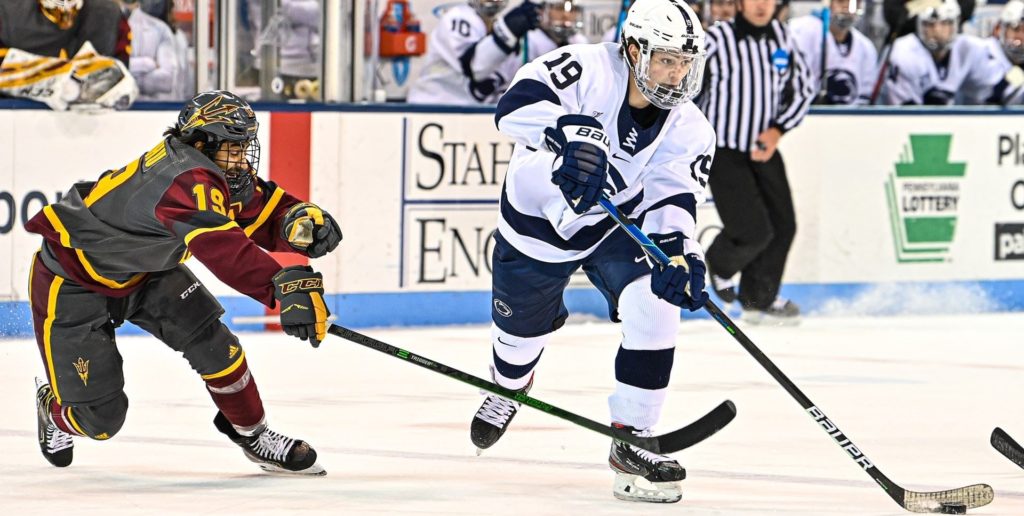
Each week during the season, we look at the big events and big games around Division I men’s college hockey in Tuesday Morning Quarterback.
Paula: Well, Jimmy, there’s a new No. 1 in this week’s poll, and that seems like a good place to start.
Minnesota improved to 8-0-0 this week after sweeping Michigan on the road, and the voters rewarded the Golden Gophers for their perfect first half with 34 first-place votes.
It’s the first time since Nov. 10, 2014 that Minnesota has captured the top spot in the poll, and it’s the first time since Oct. 22, 2018 that a Big Ten team has been No. 1. That team was Notre Dame, who held the spot for a week following two weeks during which Ohio State was No. 1.
That, as I’m sure you remember, was the season that followed the Frozen Four in St. Paul, where Ohio State, Notre Dame and Michigan made up three-fourths of the field. The fourth team, Minnesota Duluth, won the first of its back-to-back national championships in 2018, but at the start of the 2018-19 season, voters were optimistic enough about B1G Hockey to throw first-place votes at both the Fighting Irish and Buckeyes for the first three weeks of that season.
Given the way this season has begun with fewer teams playing overall and very limited interconference play, what does this return to the top spot of the polls say for a league that hasn’t been there in two years?
Jim: Well, first off, hats off to Minnesota for rising from 14th in the USCHO preseason poll all the way to No. 1. That’s an impressive jump in what has really been about a calendar month of play.
That said, I think this is a bit of a microcosm for the Big Ten in general. I’m impressed with the talent in this league, top to bottom. As I look around results of this league, I almost feel like there is a similarity to the NCHC in terms of parity. It has been difficult for many of the teams in this league to put together win streaks, which makes the Gophers eight wins right out of the gate so much more impressive. But you also look to the other end of the league, where Penn State began 0-5 but have since pulled off three straight wins.
The one difficult question to answer at this point, as pretty much every conference is only playing against its own membership, is to understand how strong each conference is compared to one another. I look at North Dakota and Minnesota Duluth, two extremely strong teams that lost in the past week. Each team played four times and played against NCHC opponents who most believe will be in the national picture come season’s end.
In full transparency, I gave my first place vote to Minnesota, but it wasn’t without questioning just how good, say, Minnesota Duluth is as well given they’ve played a grueling schedule in the NCHC pod and lost just once.
How difficult is it to make a fair comparison this season?
Paula: That’s the question, isn’t it? The short answer is, “Very.”
With B1G Hockey, at least, we get to see how the teams stack up against one solid nonconference opponent in Arizona State. Penn State’s impressive back-to-back overtime wins against the Sun Devils showed that the Nittany Lions may, indeed be turning things around. After all, Arizona State put together a three-game win streak that included a sweep of Wisconsin and a split with Notre Dame, and there is no question that the Badgers and the Irish are solid this season.
But to your bigger question, it’s so difficult to gauge how leagues may be in relation to each other this season, which makes taking that weekly snapshot with an USCHO poll ballot even more difficult. My full disclosure: I voted for Boston College in spite of BC’s loss to and near-miss overtime win against Connecticut. My vote comes in part because of Hockey East’s depth from a season ago and the Eagles’ own depth, plus the strength of its freshman class.
Frankly, that’s the same rationale I have for voting Michigan in the top 10 in spite of the Wolverines’ 5-5-0 start and their below-.500 conference record. Michigan is massively talented, deep, with an incredible freshman class – and, as you say, they’re competing in a really tough conference this season.
I look at what the Big Ten has done in such a short period of time in the first half of this season and I am impressed with the talent from top to bottom plus the improvement in every team from Nov. 13 onward. Then I look at the NCHC and I think nearly the same thing. Incredible talent. Consistently tough competition. Parity from nearly top to bottom. A compressed first half.
It is hard to compare. It will be a shame if the first and only time we see interleague play this season is next March – or whenever D-I hockey manages a playoff leading up to a national championship.
Jim: That does seem to be reality, Paula.
The only intraconference play we will likely see are the limited number of games between Atlantic Hockey teams and the ECAC or WCHA. I can think that the ECAC’s four remaining teams are going to make the long treks to play WCHA clubs. Hockey East, the Big Ten and NCHC have already said they are staying insular with their scheduling.
Which brings back a question that I know we have touched on a bit in the past – the NCAA tournament. If there is a tournament this year, how would you proceed picking teams?
If I were the committee, I personally would want as little involvement as possible. You don’t have the PairWise to serve as guidance and the lack on nonconference play makes deciding what teams make the tournament more difficult. So here is my thought: Allow each of the six conferences two have two bids – they can decide how to allot them. Maybe it is the regular-season and postseason champions? If the same team is both, let the leagues decide.
Still, that leaves four bids to be handed out. And in this extremely unique 2020-21 season, this might be the year to allow the committee to decide. Bring back the days of smoke-filled rooms where the committee is lobbying for the right teams to put in the NCAA field.
It would be fun to prognosticate, right?
Paula: I love the idea of letting each conference have two autobids going to the regular-season and playoff champs, with the conferences coming up with criteria for who to send if those are one and the same.
It would be interesting to see a conference go with the non-championship team with the highest win percentage, for example. I can hear the grumbling across D-I already about each league deciding its own criteria, and I think that in itself adds an interesting wrinkle to an already strange season.
In the early days of the PairWise, I remember CCHA coaches whose teams were on the bubble making their cases to me with impassioned speeches. No matter how much I told them that 1) I didn’t have a say in the matter, and 2) it was all fairly routine and formulaic, some still thought that lobbying might have an effect somehow. To those coaches back then, it seemed like the act of speaking their hopes out loud was like a spell against the fates their teams eventually met. I’m sure they knew what was coming, but it was important to them to argue, plead, talk, fight.
Although I’ve been known to lapse nostalgic and I do enjoy a little mystery, I am not making an argument for a return to a murkier past. Like the rest of the world, college hockey will have to remain flexible as the immediate future unfolds. As amusing as it is to contemplate a committee sweating over the national playoff tournament field because that image harkens back to a time before everything was more calculated, I think that at this point in human history, even the illusion of predictability is an underrated thing.
Jim: I think that transparency has been the utmost of importance to those in the college hockey world when selecting the tournament — including the coaches — but in this year, it seems like it is difficult to find any computer system to seed the tournament.
That, is getting way too far ahead of ourselves. Right now, I think we’re thinking about the flexibility of getting through the regular season, hopefully the ability to conduct a postseason tournament for all six conferences, and then – and only then – can we really have an idea of how to seed the NCAA tournament.
Does that mean we won’t talk about it between now and then? Ha, no. I’m sure it will be a topic as we cross over into 2021, though.


